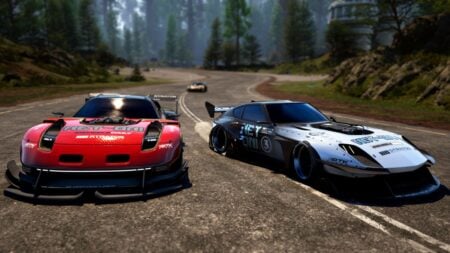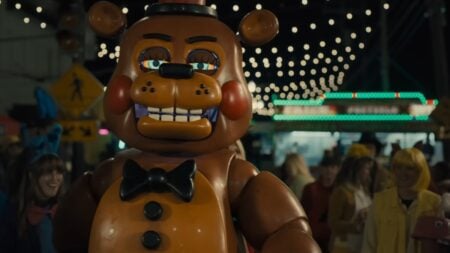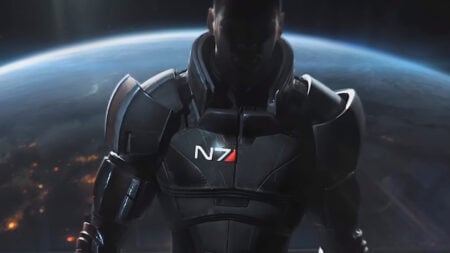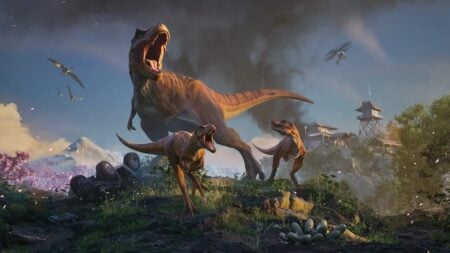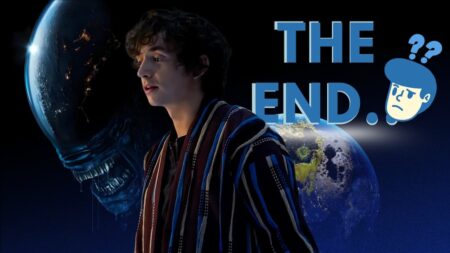Film television audio has to be meticulously recreated in post-production as sound is rarely perfectly captured on set. Sound editors and re-mixers are responsible for the roar of a car’s engine, or the pound of a ball hitting a wall. It’s a delicate process that requires skill and precision. Earlier this month, The Nerd Stash had the opportunity to interview James Parnell, a talented sound editor who has recently been working on the Twisted Metal series on Peacock prior to the Season 1 release. He’s had years of experience working on other action-packed blockbusters and long-running comedy series, too. In our time with Parnell, we learned the craftsmanship behind designing the sound of cars, characters, and more in Twisted Metal. He delivered stories about his time on successful projects, such as why Jordan Peele‘s Get Out clicked with him after not fully seeing the vision behind the acclaimed horror film.
Interview With James Parnell, Sound Editor for Twisted Metal

I want to start by talking a little bit about your job as a sound editor. What is a part of the process of developing the sound of a show or movie that you think is the most surprising aspect for people who don’t know much about it?
James Parnell: I think the thing that a lot of people don’t realize is that, other than the dialogue, everything is recreated. So even the sound of somebody sitting down, grabbing a can of soda, you know, tapping on the table, scratching their hair – unless that’s like pristinely recorded on set, a lot of that is re-recorded. And obviously, recordings that are done on set, like in the case of Twisted Metal with cars, we would use the sonics of that car to kind of inform our decisions, but all of that would be completely recut. So anytime you watch a TV show, like Game of Thrones, or any big production, 90% of it is all recreated from scratch or from libraries of recordings that we have from Foley performances. Yeah, it’s a complete recreation.
And what would you say you think are the biggest challenges to tackle when you’re working on a project?
James Parnell: The answer might be twofold. So, one is that you’re working closely with – in the case of television, a showrunner, and in the case of film, a director – and you want to make sure that you’re expressing their creative vision sonically. So, you’re doing everything you can to lend the project the best sound possible to help enhance the storytelling.
So that’s one, and then two is finding moments that can really make scenes shine. So, for example – and I keep bringing this back to Twisted Metal – for all of the cars that we see in the initial teaser, I think everyone on the internet is referring to it as Roadkill. But initially, John is driving a car that he kind of built from scratch himself. He took an existing car, but kind of souped it up and remodeled it. And it’s called Evelyn and you know, little things like MJ [Michael Jordan Smith], the showrunner asked, “What can we do to really make it sound slick like he’s put love and care into this car?” Even though we’re in a post-apocalypse, he’s put an aftermarket exhaust on it; he’s got a really slick gear shifter. And we were talking about this concept of like, giving it a turbo boost sound kind of like the DeLorean. That was like a big thing.
Little things like that; almost like a song that has a really recognizable top line. It’s like those single sounds that grab your ear – sometimes, we call it ear candy – really help engage the viewer. So, for example, in Twisted Metal, Evelyn has this turbo boost. And in the opening shots of episode one, you see John drifting around this corner, and he hits the turbo boost, and you can hear this high-pitched NOS exhaust system kick in. He does it several times in the show when getting away from enemies and bad guys and stuff like that.

I liked your reference to music there. Because – and correct me if I’m wrong – you used to play drums in a band, right?
James Parnell: Yeah.
Has that background in music kind of informed your decision-making and your skills when you’re working on a show or a movie?
James Parnell: Yeah, I think definitely in post-production, there’s a musicality to it. You have to pick and choose your moments of when things are going to play, just like a song. So, you know, if there’s a drum solo or lead guitar line, or the band is at the back wall and vocals play, it’s very musical. Obviously, it’s not just post-production. It’s more than just music. It’s dialogue and sound effects and folium. [The] ambiance isn’t all this stuff, but it’s not unlike music mixing and music recording.
Certainly, you’re finding moments to play certain elements and making sure that those elements are serving what you’re seeing on screen. Then, you know, in the case of a big car sequence, for example, there’s lots going on: There are guns, ricochets, tracer rounds, car engines, dialogue. So, all of those moments need to have their pockets to shine, and then they need to disappear to focus on something else. And you need to do that in a way that doesn’t feel lumpy, doesn’t feel unintentional. All of it needs to play like a song, kind of.
I’ve seen some really interesting sound-creation videos on the internet, like cracking celery to make sounds like bones cracking or breaking. But are there any particular sounds that you find to be either very easy to replicate or very difficult?
James Parnell: Yeah, I mean, I think there have been so many good action movies that have guns, that I think there’s like, an industry standard for when you watch something – if there’s like a gunfight, like, “Oh, that sounds like a gunfight.” And I think that our sound libraries are so robust in that regard now. Back in, say, the ’70s and, you know, the early ’80s, the recordings of guns weren’t as robust. The fidelity of those recordings wasn’t as great. But nowadays, you know, I wouldn’t say it’s easy to cut a gun and shoot out scene because there are lots of slivers of audio, like shells and trigger clicks and stuff like that. But the library that you go to, or your kind of toolkit that you pull from, has a lot of great sound. So, I think that it’s easier to get a scene sounding the way you want it to, in that regard.
Regarding difficult stuff… Certainly, you know, there are people who are known for their car sound design, their engine builds, and things like that. And car sound design can be really finicky, just because, oftentimes, you don’t have access to the car that’s on screen. So, say, for example, it’s like a vintage Mustang from the ’60s – like ’69. You have the recordings that came from the set a lot of times or you have to find someone who’s gone out and bespokely recorded that library. And even then, you might not have every movement of the car that you’re seeing on your screen. The person that recorded that library didn’t get all of those movements.
So, you need to hybrid the library with cars that are six-cylinder carbureted engines. You need to find cars to sweeten, and you need to add tire peel-outs and skids that might have come from different recordings of different cars but that you believe when you hear it on screen because that’s the meat and potatoes of the engine, for lack of a better term. So, sound designs that are for sci-fi – that can be difficult with spaceships and things like that.
Yeah, for the fantastical, you have to wonder, “Well, what would this sound like?” You have to use your imagination a little bit.
James Parnell: There’s been this big debate – not to harp on about it – but concerning where sound effects live versus where sound design lives. And there’s always been this kind of separation of sound design and sound effects, sound design being traditionally thought of as designing the sound for somebody that doesn’t have an earthly basis. So, spaceships, dinosaurs, monsters with lasers that shoot out of their eyes, things like that. So yes, sci-fi can be very difficult to hit just right.

Before you signed on for Twisted Metal, did you have any history with Twisted Metal as a franchise? Or maybe a history of playing video games?
James Parnell: So, I remember going to my friend’s house and them having the original PS1 and playing Twisted Metal, the original game, and thinking, ‘Wow, this is crazy. It’s like [a] demolition derby.” And I was young at the time. I’m 38 now. But then, I remember asking my parents to go to Blockbuster Video. You know how you could rent consoles for like a weekend back in the day? So, we rented a couple [of] games, and Twisted Metal was one of them. And then I put the game down for a while, and then in summer, I think it was before University, Twisted Metal: Black came out.
I went to my buddy’s place who had a PS2, and I remember him having Twisted Metal: Black, and I was like, “Oh, this is cool.” And then I was old enough to know that the game had shifted tones. It got really dark and kind of macabre and gritty, and I was like, ‘Well, this is a completely different game.” And obviously, the graphics jumped significantly further ahead. And it was way more immersive to play, and the sound was better. So yeah, that’s kind of the sum total experience I had going into the show. But I definitely remember Sweet Tooth and Agent Stone and Raven and all those characters.
Has it been nostalgic working on the show? What was it like thinking, “Oh, I just signed on to work on Twisted Metal!”
James Parnell: Yeah, it was crazy. I remember I worked at a company called Monkeyland Audio. And my company director Trip [Brock] was like, “Hey, we’ve got this show coming in. It’s for Peacock and Sony. It’s called Twisted Metal.” And I was like, “You’re joking me.”
I couldn’t believe that they were, in the best way possible, super happy that they were making a TV show based on the game. And I was thrilled. I was really excited to see where they were going with it. And then we found out that MJ was on the show, who created and wrote Cobra Kai. I thought, “Oh, this is going to be interesting because he’s known for doing great work and infusing nostalgic shows with comedy.’
Anyway, I remember going to the initial sound spotting session, which is where we sit and watch the rough cut of episode one. And it’s got temp sound that the picture editors kind of put in there. So, everything’s kind of dulled down only because they don’t have access to the sound tools that we have. But I was blown away. And I was super amped to start the project. It was cool. The first episode definitely keeps you on the edge of your seat the whole time. And it’s action-packed and super fun.
What was it like adapting a video game into the form of a live-action TV show?
James Parnell: Yeah, it’s tricky when it comes to adapting a video game because the video game community can be pretty ruthless, but also, if they love it, they champion it, and it’s awesome to see.
So immediately, when we were put on Twisted Metal, I was like, “We have to get access to the original sounds of the video game.” It wouldn’t be enough for me to just rent an old PS or buy an old PS2 and get Twisted Metal: Black and play it and try to pull inspiration from that because you can obviously watch gameplay on YouTube. So, we contacted Sony’s video game division as well as their licensing division. And it was, with no exaggeration, probably about a two-month process of figuring out whether Sony actually owned the licenses to the sounds and the video game and whether we were allowed to utilize those sounds. And then, when we got the archival hard drive, the sounds used in the video game, we realized that back in the early 2000s and late ’90s that all the sounds on those discs are like mp3 recordings, and to make the sounds as awesome as the games were, these wouldn’t cut through the mix, so we had to use them as a platform to emulate from.
So, the very first port of call was to get the archival sounds and figure out where they were going creatively with it. So, there was specific creative attention paid to utilizing the original sounds of the video game, and then it was also, “How do we create the sound of Sweet Tooth and keep it as authentic to Twisted Metal: Black as possible?” Obviously, Will Arnett wasn’t the voice of Sweet Tooth in the games and Will adds character to his performance and he can go from super funny to super psychotic in a split second. So, we had to develop a vocal processing chain for him so that we would pitch down his voice, give it some tremolo effect, and really try to pay homage to the game franchise.
And then also to go back to something we talked about earlier, about highlighting or adding a top-line sound to everything you know, a big part of Twisted Metal is obviously the driving, but the combat is a big thing too. So, each car sounded different, and we needed to give each its unique sound. So, Evelyn has the turbo, Roadkill has a really dirty beefy engine that a Camaro has, Twister’s is in the show. A Formula One [is] driven by Amber Watts.
We had to find sounds for all those cars and then find the sounds of weapons attached to those cars. So, the biggest example is Sweet Tooth because he’s got two miniguns on the side of his ice cream truck, which need a sound like miniguns, but then he’s also driving this really janky truck. He’s got this chain that he pulls where a window pops up, and a really rusted machine gun pops at the side. So, we needed to make his weapons sound different than, say, John Doe’s weapons and Twister’s weapons. Obviously, visually, they look different, but some of them, some of the cars, just like Stone’s car, have similar-looking machine guns to John’s car, but sonically we need to make that distinction. There was a lot of effort made in not just paying homage to the original franchise but creating that sonic separation where we would immediately know what car was about to come on screen, or from the gun firing which car you’re about to see.
Whether it’s Twisted Metal or anything else, do you ever pay attention to what the online reactions are?
James Parnell: Yeah, I do. I mean, it’s hard. For example, they released the teaser, which was a 60-second clip. You see John driving through the apocalyptic wasteland, and then you see Sweet Tooth shoot the thing. And everyone was like, “Ah, this could be good.” And people were criticizing music choice. And then they released the sneak peek. Everyone was bummed because there were no cars. But I think the biggest thing was that – and I don’t know whether this was a reactive thing from Peacock releasing the scene with Sweet Tooth – fans could get a flavor for what Sweet Tooth was like in reaction to the teaser only having a certain clip of him.
But yeah, I do. I’ve looked at the comments on YouTube and stuff like that. And, you know, you take everything with a grain of salt. And I think, in a good way, if people are talking about it, that means that people are gonna watch. And I was talking with a friend about this. She was like, “You know, the people who were hating on it are gonna be the ones that subscribe to Peacock and watch it.” So, I mean, I think it’s got that audience built in. It’s nostalgic. A lot of my friends grew up playing that video game.
I think that the stuff that people have seen doesn’t do the show justice in so much as you don’t see any of the combat, and there’s loads of it. You don’t see any of the explosions; there’s loads of it. There’s loads of characters you haven’t seen yet. And you saw like a one or two-minute clip of Sweet Tooth’s, the last part of his interaction with John Doe, but there’s a whole scene prior to that where the opening of episode two is that he’s being chased by Sweet Tooth for three and a half minutes through the last Las Vegas desert and being fired upon. He’s using maneuvers to get around him. It’s just this chaotic car chase, and they end up smashing into a hotel where Sweet Tooth lives – the Monte Carlo Hotel. I think that people are just seeing the snippets and being like, “Oh, this isn’t gonna be good.” But I know in my head that it’s this excellent episode. It’s the second episode and it’s heavily stylized and it sounds great.
You’ve worked on a lot of different genres. Do you feel like the work is a bit different when you touch on different genres and how do you adjust to them?
James Parnell: I’m working on an independent horror movie right now, which is kind of similar to Twisted Metal in so much as there are similar sonics you need to create suspense, and there’s action stuff. But definitely, when you go from a documentary to a comedy and then to Twisted Metal, it’s a completely different exercise, such as for shows like PEN15, which was awesome. It’s much more toned down in terms of what’s required sonically; you’re still performing the same tasks in so much as trying to accentuate the storytelling and the sound but in a different way. Oftentimes, in comedy, it can be a little bit lighter, and you can be a little bit more playful with the sounds.
In Get Out, obviously, it’s a horror movie; I was only an assistant sound editor on that. But with horror you’re oftentimes building up to jumpscares or frightening moments. And sometimes, in the mix, you’re pulling sounds down. So, things get really quiet right before a jumpscare to give that moment, [the] impact, is like reducing the sounds, and people lean in to listen, and then you’re immediately smacked in the face with sound. It gets your heart rate going. So, it definitely takes some skill and some practice flipping back and forth. But I think if you ask most people in the industry, we all work on different genres and different projects. Certainly, some are the horror people and the action people, but I’ve been lucky enough to do a whole bunch of stuff.
And when you work on a specific genre numerous times, how do you feel you grow within that genre?
James Parnell: I think if you do anything over and over again, you get a better sense, an instinct of like, “Is this going to work? Or are we going to spend time experimenting with it to get it sharper?” And you make sonic choices quicker, and they’re often better informed and they can help tell the story better. So, I think that repetition is a big thing.
You look up to some of these people in [the] industry [who] have been doing it for years, and their stuff sounds amazing. And it’s just because they’ve had that practice over and over again of working on familiar territory, like “Okay, this is how we’re going to create this suspense. This is what we can lean on.”
In the horror movie I’m working on right now, there’s a scene where they’re climbing through an air duct, and that can be a really normal scene, but we added all this metal droning, and we’re putting loads of reverb on it. So, we’re hearing it from down the tunnel and behind them and kind of panning it all around the room. And just suddenly adding that in, I think, adds a layer of texture, which could otherwise be a completely boring scene of just hearing their bodies crawling through this metal duct. It’s little things like that, that you just know to go to. “This will make it sound amazing.” It allows you to get there quick.
I’m a huge horror fan, so you’re already selling me on this project that you’re working on. Is there anything that you’ve seen recently, a show or movie, where you’re just sitting there watching it, and you go, “Wow, the sound in this is incredible”? Is there anything like that?
James Parnell: The sound of Game of Thrones was fantastic. So many shows these days are getting so good. I think the bar, especially within television, is raising and kind of stepping away from those standard 30-minute network sitcoms or procedural dramas or stuff like that. I think that streaming has allowed us to tell stories that are longer, episodically, so instead of an hour show being 44 minutes or a half hour, 22 minutes, we can use up the full 50 minutes. And I think we’ve entered into an age where the overall quality has gone up. I don’t think anyone can argue that, yes, as I said, Game of Thrones sounds fantastic. And that whole, you know, the House of the Dragon spinoff or prequel, sounds fantastic.
There are some other really cool shows. There’s a show with Bryan Cranston called Your Honor, which only had one season, but I thought it sounded fantastic. Weirdly, I’ve recently been going back to watching The Sopranos. And some of the sonic choices that the team made, obviously quintessential for the time period – it was [the] late ’90s, early 2000s – but I think overall, the show sounds fantastic. Really puts you in New Jersey, New York. And I think there’s been a progression of amazing sonic storytellers if you want to call it that.
Is there anyone who you feel has helped you grow professionally? Some sort of a mentor-like situation? Or maybe some advice you got from someone?
James Parnell: Yeah, I mean, there’s, gosh, too many to count. I mean, I would definitely give credit to living in the U.K. for a couple of years and working in television there. It was like a four-person team that I worked on. And those guys – Tony Wall, Matt Jones, Johnny Allen, and Adam Legg – all of those guys are definitely respected colleagues.
When I moved over to L.A., I was super fortunate to intern for a guy named Marti Humphrey, who’s, you know, he’s a legend. He’s mixed a ton of horror and other features in the industry; he mixed The Grudge. And he was basically responsible for giving me my first step in L.A.
When I moved and got a job a proper job in L.A. working for Jonathan Wales, who is also fantastic, he mixed Get Out. So, I just happen to luck out, and land in these places where everyone was striving to deliver the best product and create the best soundscape and really achieve these iconic movies with sound. And then I worked in computers and audio with Trip Brock, who’s fantastic, and he’s given me all of the opportunities that I’ve had thus far.
I have to end by talking about Get Out because I love that movie, and I have to thank you for your contribution to that movie. It’s one of my favorites. So, what was it like working on a Jordan Peele film?
James Parnell: Yeah, it was really cool. I got some cool stories about it that I can tell you. As a disclaimer, I was only an assistant sound editor on that movie. So, what that meant was I received the picture turnover from the picture department, meaning we would get the new reels of footage. I would turn over there; what happens is when a picture editor turns over material, they give you a rough audio timeline of what they’re working with, which is [a] much more dumbed-down version of what it’s going to be, but it gives you the kind of creative intention.
So, I remember getting the original reels and being like, “I don’t get this movie. It’s good.” I didn’t get it. And then I happen to walk onto the mix stage the day they were cutting in Redbone by Childish Gambino as the opening song. The way it was working was we were getting updated pictures all the time – it’s called rolling conform. We would get reels 1, 2, 3, 4, 5; they break the follow-up into five chunks or six reels, six chunks. They would make slight picture changes during the day. And then we’d get that picture at night, and we’d have to conform; move around all the audio to match the new picture timing. It can be quite a laborious process.
So, I remember constantly getting these picture updates and seeing the film [get] tighter and tighter and just more awesome. And then I walked onto the mix stage when they literally were like, “Well, we have a couple of songs. Let’s drop them in and see how we feel.” And I kind of just stood quietly in the back of the room being like, “Nobody knows I’m here, but I’m just gonna watch this happen.” I remember when they dropped in the Redbone song by Childish Gambino. Everyone in the room was like, “Oh my god, this is it.” Everyone was vibin’. And I was like, “Okay, I totally get this film now.”
It’s funny because I had to see it in from the early rough cuts through the iterations of tightening up the film to really appreciate what they were doing. And it was this new kind of avenue in the horror genre where it’s weird. It’s like suspense mixed with horror. I don’t know. It’s really cool and unique. And I don’t know whether you’ve seen Nope, but I thought that was fantastic.
Oh, yeah. I loved it.
James Parnell: Yeah. And it’s amazing too, because is it a sci-fi movie? Is it a horror movie? Is it a thriller? He artfully dances through these three genres, and you’re never really sure where you as a viewer should be. Should you feel scared? Or is something funny gonna happen? He’s really talented. He’s a really nice guy as well.
That’s great to hear. I’ve heard very nice things about him, and he’s one of my favorites. I think there are just some directors who defy genre. Like, it’s just a Jordan Peele movie. You know, don’t call it a horror movie, it’s Jordan Peele. You go, okay, I know what that means.
James Parnell: Exactly. Yeah, totally. I would agree.
Thank you so much for your time, James. And best of luck to your upcoming projects, including Twisted Metal. I hope it’s a huge hit. And hopefully, one day, we’ll chat some more and get to know whatever else you’re working on, especially this upcoming horror project. You have piqued my interest.
James Parnell: Yeah, for sure. It’ll be fun to talk about that later down the road. And yeah, it’s nice meeting you as well. Thanks for taking the time.
—————————————-
That wraps up our interview with James Parnell, who has plenty of sound editing to keep him busy over the coming months. His most recent project starring Anthony Mackie, Twisted Metal, is available on Peacock, as all ten episodes were dropped on the streaming service on July 27. His other upcoming projects include the coming-of-age film Marisol, the comedy Tapawingo, the documentary The Coddling of the American Mind, the thriller Breakwater, and the unannounced horror film he mentioned during our talk with him.


